
Features
Agronomy
Fertility and Nutrients
Phosphorus management for irrigated potato production in Manitoba
Results of a set of field experiments evaluating potato response to recommended rates of P fertilizer demonstrated yield benefits in two of four years, and consistent increases in post-harvest Olsen P levels. Findings suggest that petiole critical nutrient concentrations developed in other potato-growing areas may require regional adaptation for Manitoba.
April 6, 2009 By by Dr. Ramona Mohr and Dr. Dale Tomasiewicz*
* Reprinted from Better Crops with Plant Food, with permission of International Plant Nutrition Institute (IPNI).
Results of a set of field experiments evaluating potato response to recommended rates of P fertilizer demonstrated yield benefits in two of four years, and consistent increases in post-harvest Olsen P levels. Findings suggest that petiole critical nutrient concentrations developed in other potato-growing areas may require regional adaptation for Manitoba.
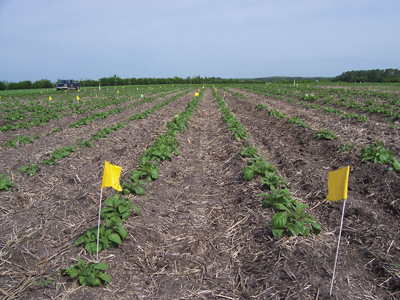 Advertisement
|
|
| Timing of plant counts, mid-June 2005. | |
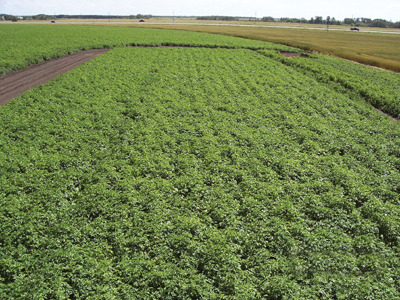
|
|
| Southern Manitoba P and potato research site, August 2005. | |
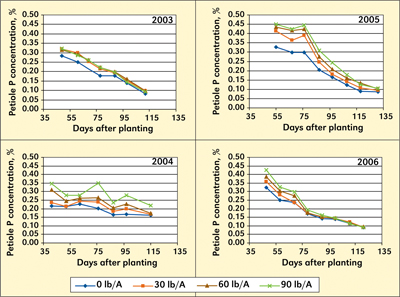
|
|
| Effect of rate of P fertilizer (lbs P2O5/ac applied as broadcast MAP) on total P concentration in petioles of irrigated Russet Burbank potato in Manitoba (2003-2006). | |
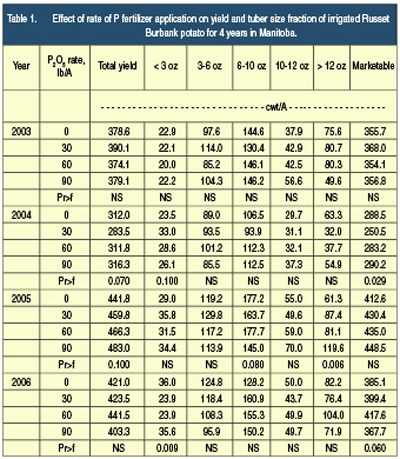
|
Manitoba has become a major contributor to potato production in Canada,
with output of more than 12 million cwt of processing potatoes valued
at $97.3 million in 2001. While P is routinely applied to most potato
fields in Manitoba, much of the research regarding potato responses to
P in Manitoba was conducted in the 1960s. More recently, Geisel (1995)
and Tomasiewicz (1994) conducted field trials to assess P response in
irrigated potato. In five field trials conducted from 1991 through
1994, Geisel (1995) reported significant yield increases with P
application in two of five trials, with yield increases evident only
where soil test P levels were less than 40lbs/ac. In a one-year study,
Tomasiewicz (1994) found no effect of P application on potato yield or
quality for a site that, based on the soil P level, would have been
expected to respond to P fertilization most of the time. The objective
of this study is to determine the effect of recommended rates of P
fertilizer on tuber yield and quality, petiole P concentration, and
postharvest Olsen P levels for irrigated processing potato.
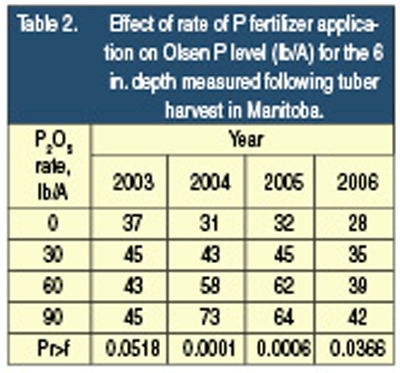
|
| Abbreviations and notes for this article: N = nitrogen; P = phosphorus; cwt =100 wt or 100 lbs; MAP = monoammonium phosphate; K = potassium; S = sulphur; NaHCO3 = sodium bicarbonate; ppm = parts per million. |
| Photo credits to the International Plant Nutrition Institute.
|
Four field experiments were conducted in Manitoba from 2003 through
2006 to assess the impact of P fertilizer rate on irrigated Russet
Burbank potato. Field experiments were conducted on Orthic Black
Chernozem soils near Carberry in 2003, 2004 and 2005 (pH 5.6 to 6.2)
and near Douglas in 2006 (pH 6.8). Sodium bicarbonate extractable P
(Olsen P) levels for the six-inch depth were 43, 24, 34 and 19lbs/ac in
2003, 2004, 2005 and 2006, respectively. A randomized complete block
design consisting of four replicates of four P fertilizer rates (0, 30,
60 and 90 lbs of P2O5 per acre as MAP) was established. Individual
plots were typically 52 feet long, and ranged from six to nine rows
wide. Row spacing was 37 inches and within-row spacing was typically 15
inches. Blanket applications of N-, K-, and S-containing fertilizers
were made as required to ensure nutrients were non-limiting at all
sites. Nitrogen applications were adjusted for each P rate to account
for N applied in the MAP in order to ensure that all treatments
received equal rates of fertilizer N. All pre-plant fertilizer was
surface broadcast, and then thoroughly incorporated. In select years,
additional N was top dressed and incorporated at hilling. Potato (cv.
Russet Burbank) was planted between late April and late May depending
upon the year. Approximately 36 to 39 feet of the centre two rows of
each plot were harvested the third week of September each year. Pests
were effectively managed and irrigation water applied as required.
In the spring prior to plot establishment, soil samples were collected
and the Olsen P concentration determined. Petiole samples were
collected at approximately 10-day intervals throughout the growing
season. Shortly before tuber harvest, whole plant samples were
collected and separated into vines, recoverable roots plus stolons, and
tubers. In 2005 and 2006, whole plant samples were collected in all
treatments; in 2004, only the 0 and 90lbs of P2O5 per acre treatments
were sampled.
Growing season conditions varied among years. Cool conditions prevailed
throughout the 2004 growing season and, in 2005, precipitation levels
were above-normal in the early part of the growing season. Total tuber
yield varied among years, averaging 380, 306, 463 and 422 cwt per acre
in 2003, 2004, 2005 and 2006, respectively. The comparatively lower
yields obtained in 2004 were due in part to cooler growing season
conditions, including frost in August.
Phosphorus fertilization appeared to have limited effects on tuber
yield and quality although the experimental sites selected would have
received a recommendation for P fertilizer based on the “Manitoba Soil
Fertility Guide” (Manitoba Agriculture, Food and Rural Initiative,
2007). Total tuber yield increased linearly (p = 0.02) with increasing
P fertilizer rate only in 2005 (Table 1). Phosphorus rate had no effect
on total tuber yield in 2003 and 2006. In 2004, P rate tended (p =
0.07) to influence total tuber yield. Closer examination of the data
revealed that the treatment receiving 30lbs of P2O5 per acre had a
numerically lower yield than any other treatment, although the reason
for this effect is unclear. In 2005 and 2006, increasing P rate
increased marketable yield (Table 1). A significant linear effect was
evident in 2005 (p = 0.03), and a significant quadratic effect was
evident in 2006 (p = 0.02). In part, a somewhat higher soil test P
level in 2003 — and poor growing season conditions that restricted crop
growth in 2004, may have limited crop responses to fertilizer
application in those years.
The rate of P fertilizer applied had limited effects on tuber quality
(data not shown). Specific gravity was not affected by P rate except in
2004 when increasing P rate resulted in a statistically significant
linear increase in specific gravity. In 2003, P rate tended to
influence specific gravity, but increasing P rate had inconsistent
effects. The occurrence of defects such as rot and greening was
generally very low throughout the course of the study, while the
occurrence of hollow heart/brown centre averaged 15.2 percent, 15.1
percent, 9.5 percent and 2.1 percent of the tubers assessed (on a
weight basis) in each of 2003, 2004, 2005 and 2006, respectively.
Preliminary analysis suggests that P rate had limited effects on hollow
heart.
Petiole P concentration generally declined over the course of the
growing season (Figure 1). In 2004 and 2005, increasing P rate
increased petiole P concentration for each sampling date. In 2006,
increasing P rate also increased petiole P concentration in the early
part of the growing season, but this effect was not evident for later
sampling dates. In 2003, P fertilization similarly increased or tended
to increase petiole P concentration at most sampling dates, but effects
were not as pronounced as in 2004 and 2005. In an extension bulletin
from the University of Idaho, petiole P concentrations of less than
0.17 percent were considered low, 0.17 to 0.22 percent marginal, and
greater than 0.22 percent sufficient for the fourth petiole of Russet
Burbank potatoes during tuber bulking (Stark et al., 2004). In the
current study, petiole P concentration in most treatments at most sites
fell below 0.22 percent as the season progressed. However, increasing P
rate increased marketable yield only in 2005 and 2006.
Woods et al. (2002) reported that the adequate range for petiole P
based on standards used in the northwestern US ranged from 0.22 to 0.62
percent in early July, from 0.20 to 0.50 percent in late July, and from
0.16 to 0.40 percent in mid-August. Using these criteria, the petiole P
concentration in all treatments in all site-years fell within the
adequate range in early July. Petiole P concentration also fell within
the adequate range in late July in all years except 2006 where petiole
P concentration fell below 0.20 percent by the July 20th sampling date.
In 2003 and 2004, petiole P concentrations were also adequate in
mid-August, suggesting that P was not limiting (increasing P rate did
not increase yield at these sites). In 2005 and 2006, petiole P
concentration in some treatments fell below the adequate range in
mid-August. However, petiole P concentration in some treatments did not
consistently predict when yield responses to P application would occur
at these two sites. In 2005, petiole P concentrations were greater than
or equal to 0.16 percent in mid-August only in treatments receiving 60
and 90lbs of P2O5 per acre, suggesting that P was not deficient in
these treatments. However, a linear yield response was evident at this
site with marketable yield increasing across the range of P fertilizer
rates. Additional site-years of data are required to further assess
petiole P criteria for Manitoba conditions.
Estimated P uptake by the potato plant shortly before tuber harvest
averaged 16lbs of P per acre in 2004 and 2006, and 20lbs of P per acre
in 2005. This estimate included vines, tubers, and recoverable roots
plus stolons. Average P uptake in tubers was 12, 16 and 13lbs of P per
acre in 2004, 2005 and 2006, respectively. Increasing P fertilizer rate
did not result in a statistically significant (P greater than 0.05)
increase in P uptake in 2005 and 2006 where all treatments had been
sampled. Detailed sampling of each plot (based on 10 cores per plot to
six inches 6 inches) following tuber harvest revealed a significant
linear increase in Olsen P content in all years (Table 2). However,
treatment effects were not always statistically significant using this
sampling method. The difference in Olsen P level between the 90lbs of
P2O5 per acre treatment and the control ranged from 8lbs of extra P per
acre in 2003 to 42lbs of extra P per acre in 2004.
Increasing P fertilizer rate resulted in a significant linear increase
in marketable (greater than 3.0 ounces) and total yield only in 2005,
and a quadratic increase in marketable yield in 2006, even though all
experimental sites would have received a recommendation to apply P
fertilizer based on Manitoba guidelines. In the current study, the
range of P fertilizer rates applied reflected provincial guidelines in
Manitoba, which recommend application of 90 to 110lbs of P2O5 per acre
for soils containing less than 10 ppm Olsen P, 70 to 80lbs of P2O5 per
acre for soils containing greater than10 and less than 15 ppm P, and
60lbs of P2O5 ac for soils containing greater than 15 ppm P, assuming
broadcast incorporation (Manitoba Agriculture, Food and Rural
Initiatives, 2007). It should be noted, however, that P fertilizer
recommendations for potato vary considerably among regions. Based on
North Dakota guidelines (Dahnke et al., 1992), for example, P
fertilizer would have been recommended in the current study only in
2004 (15lbs of P2O5 per acre) and 2006 (75lbs of P2O5 per acre) given
the Olsen P level and average total yield at experimental sites.
Comparatively higher P recommendations exist in other regions. In
Wisconsin, for example, for fine- to medium-textured soils categorized
as very low in P (less than 100 ppm P, Bray 1), 250lbs of P2O5 per acre
is recommended for a potato crop yielding 351 to 450 cwt per acre; for
soils testing low in P (100 to 160 ppm P), 180lbs of P2O5 per acre is
recommended (Laboski et al., 2006). Based on the Wisconsin guidelines,
the probability of a yield increase to applied nutrients is greater
than 90 percent for soils in the very low category.
In the current study, P application typically increased petiole P
concentration at a given sampling date; however, petiole P criteria
developed in potato-growing regions outside of Manitoba did not appear
to consistently identify when positive yield responses to P application
would occur. At all sites, increasing P rate also resulted in a linear
increase in post-harvest soil test P levels in the surface zero to six
inches.